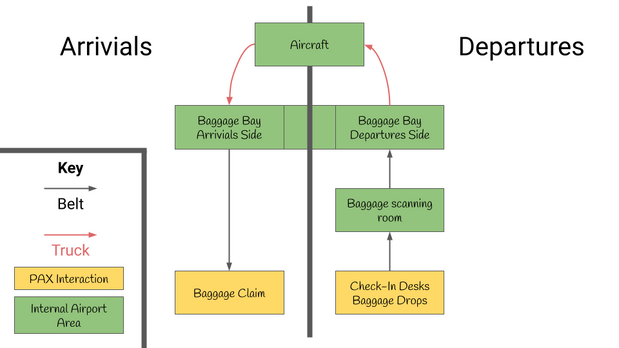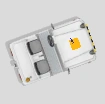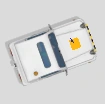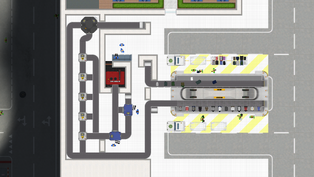This page has recently been completely re-written! The old page can still be found here.
Baggage handling is a basic service your airport can provide, and is necessary to handle medium and large flights. "Your system" refers to the system of baggage belts and trucks that transport bags from check-in desks to planes and from planes to baggage claim. Every airport has its own unique layout, so the baggage system has to adapt to that layout.
Introduction[ | ]
If an airport has a baggage handling system implemented, baggage will take a different route through your airport than their passenger owner. Baggage will be dropped off by the passenger at a check-in desk, travel trough your system, and then be put onto its respective plane.
What does a baggage system do?[ | ]
The main reason to build a Baggage System is to streamline the security process for passengers, as bags take time to scan. In addition to this, it is necessary to have a baggage system to handle medium and large flights. It is part of the progression of Airport CEO. Passengers spawn with the same number of bags whether or not you have a handling system, but if you do, they will drop a certain portion of them off at check-in. Often, one bag will stay with them as a carry-on.
General overview of the Baggage System[ | ]
In this section a brief and general explanation of the baggage system is provided. For more in-depth information, see down below. The baggage system can be divided into departing passengers and arriving passengers.
Departing Passengers[ | ]
Departing passengers (sometimes referred to as PAX) are passengers who arrive via ground transportation and leave on an aircraft. This list is in chronological order, showing all main steps.
- Baggage will spawn with PAX when they arrive to your airport via bus, car, taxi, or subway (all modes of ground transport). The passenger will be carrying or pulling the luggage with them.
- Assuming you have a baggage system built, they will then proceed to (once check-in is open) a medium check-in desk to check-in and drop their bags or check-in via an automatic check-in desk and then drop their bag at bag drop station. From here PAX are no longer included in this list.
- Bags are scanned (see below) and travel through your system.
- Bags arrive at a baggage bay, and stay there until the baggage truck for the bag's respective flight arrives, when it will be loaded onto the truck by ramp agents.
- The baggage truck brings the bag to its aircraft where it is loaded onto the plane by ramp agents.
Arriving Passengers[ | ]
Arriving passengers are passengers who arrive on an aircraft and leave via ground transportation. This list is in chronological order, showing all main steps.
- A baggage truck arrives at a flight and the bag is offloaded from said flight by a ramp agent onto the truck.
- The bag is offloaded from the truck at a baggage bay by ramp agents.
- The baggage is picked up by its passenger at a baggage claim room (see below). From here, PAX are included in this list.
- The baggage, being carried by its passenger, leaves the airport via ground transportation.
Diagram of System[ | ]

Check-in[ | ]
Baggage Belts[ | ]
Building Baggage Belts[ | ]
You can build baggage belts by clicking and dragging a Baggage Belt or High-Speed Baggage Belt. Baggage Belts can go vertical or horizontal, at 90o interval. Diagonal belts can be achieved only by combining the directions, there are no smooth 45o belts.

Building a baggage belt.
Baggage Belt Mechanics[ | ]
This section will explain different Baggage Belt mechanics which are important to know for building an effective baggage system.
Baggage Escalators[ | ]
Baggage Escalators are used to transfer Baggage between floors. This lets you to avoid having to design your main floor around baggage. Escalators have an up and a down variant, which are used to transport baggage up a floor or down a floor. Place baggage Escalators of both types on the lower of the two floors you want to connect.
Tilt Trays & Intersection Mechanics[ | ]
Looking to separate baggage based on direction or merge two streams of baggage together? This is the right place for that. Tilt trays separate baggage streams into multiple baggage streams based on a few different rules. These can be changed by right-clicking on a tilt tray. The options are as follows:
- To destination - Will send baggage on the shortest path to their destination.
- Forward & Left - Will send baggage either forward or left, randomly between the two.
- Forward & Right - Will send baggage either forward or right, randomly between the two.
- Left & Right - Will send baggage either left or right, randomly between the two.
- Forward - Will send baggage forward.
Bags can also be naturally pushed onto a baggage belt, so no special items are needed to combine two belts of baggage.

A tilt tray and intersection demo.
High-Speed Belts[ | ]
High-Speed belts allow for bags to travel through your system faster. There is a faster variant of normal belts and escalators. These function in the same way as normal belts, but just move bags faster.
Path Finding[ | ]
All types of people (passengers, staff, contractors, etc.) can pathfind over baggage belts. This means that even passengers can cross over your baggage lines.
Baggage Screening[ | ]
Introduction[ | ]
Bags that were dropped off by departing passengers (see above) should go through a security screening process in order to proceed to their flights. Failing to provide this can, and will, result in fines and a lower security rating. Screening of baggage is performed by passing baggage through scanners. There are three stages of scanners: (I), (II), and (III). Each scanner has an input and an 'accept' and 'reject' output. Bags that are deemed safe by the scanner (or staff member running said scanner) go through to the 'accept' output, while bags deemed dangerous by the scanner are rerouted to go through to the 'reject' output.
Types of Scanners & Other Items Used in the Process[ | ]
- The Generic Baggage Scanner (I) is a basic automatic scanner capable of automatic broad-range threat detection.
- The Specific Baggage Scanner (II) is an advanced automatic scanner that is searching for specific threats (Drugs, Guns, Explosives, Organics, and Money).
- The Scanning Station (III) is a manual (staffed) position that allows a security staff member to decide to accept or reject a bag.
- The Baggage Destroyer consolidates and removes rejected bags from the baggage system.
The Recommended Setup for Baggage Security[ | ]
For Baggage Security to function properly, it must be built in a certain way. Due to this being a complicated concept to grasp, multiple types explanations will be given.
Explanation[ | ]
All bags that arrive are passed through a stage (I) scanner. If they are accepted, they get routed to their baggage bay. If they are rejected, they continue to the stage (II) scanners.
Rejected bags from stage (I) are passed through stage (II). There are multiple different variants of stage (II) scanners. It is recommended to connect all stage (II) scanners behind each other in a line. If a bag is 'accepted' at the first stage (II) scanner, it gets delivered to the input of the second stage (II) scanner. This pattern continues for all 5 stage (II) scanners. All bags that are 'accepted' at all 5 stage (II) scanners get routed to the baggage bay. Bags that are rejected by any of the 5 stage (II) scanners are collected and continue together to the stage (III) scanners.
Rejected bags from stage (II) are passed through stage (III). This Scanning Station is the final point of decision for suspicious bags coming from the stage (I) and (II) scanners. Bags that are 'accepted' at the stage (III) scanner may continue to the baggage bay (see below) but routing baggage through another stage (III) baggage station is suggested, as there can be false negatives on these Scanning Stations (meaning bags that are dangerous are accepted). 'Rejected' bags from the stage (III) scanner are directed to a baggage destroyer.
Diagram of Baggage Screening Room[ | ]
Scanners are the blue boxes, where the red output is 'rejected' and green is 'accepted'.
Example of a Baggage Screening Setup[ | ]

An optimal layout that fits into a 4x4 terminal foundation.
| Number | Item/Explanation |
|---|---|
| 1 | Baggage Input from Check-In |
| 2 | Stage (I) Scanner |
| 3 | Stage (II) Organics Scanner |
| 4 | Stage (II) Guns Scanner |
| 5 | Stage (II) Explosives Scanner |
| 6 | Stage (II) Drugs Scanner |
| 7 | Stage (II) Money Scanner |
| 8 | First Stage (III) Scanner |
| 9 | Second Stage (III) Scanner |
| 10 | Bag Destroyer |
| 11 | Output to Baggage Bay |
Baggage Bays[ | ]
Your baggage bay is the connecting point between the conveyor belt part of your baggage system and the baggage trucks and flights.
Baggage Overlay[ | ]
The baggage overlay is an overlay that allows the player to see the direction and type of baggage belts. It can be toggled with the button at the bottom of the UI, or by pressing the "B" key while in-game.

Baggage Belts w/ Overlay
Baggage Trucks/On-Stand Interactions[ | ]
Baggage Truck Mechanics[ | ]
Baggage trucks are the vehicles that transport bags on the final or first leg of their journey. For departing bags, after being screened (see above), they are transported to a baggage bay. Here they wait till the baggage truck arrives for their flight. Ramp agents will load the bag onto the truck. The truck will drive on service roads to the stand, where it will park, and be unloaded by more ramp agents. The same process happens for arriving bags, but in reverse. After being dropped off at the baggage bay, the bags use your belts to a baggage claim (see below).
Baggage Trucks[ | ]
Baggage trucks come in multiple versions, with little difference between them except for looks. Though the game leads you to believe otherwise, all the types of trucks can service all the types and sizes of planes. Below are the different types:
| Name | Cost | Operating Cost | Time between purchase and arrival | Max Trailer Count | Works Best With... | UI Image |
|---|---|---|---|---|---|---|
| Small Pullforce Baggage Truck (Roofless) | $600 | $15/h | 20 | 2 | Small/Medium Stands | 
|
| Large Pullforce Baggage Truck (Roofless) | $1200 | $30/h | 30 | 5 | Medium/Large Stands | 
|
| Large Pullforce Baggage Truck (Roof) | $1000 | $25/h | 
|
Procurement/R & D[ | ]
See Main Article (check out the baggage section).
Baggage Claim[ | ]
Once the bags of an arriving flight have been unloaded from a baggage truck (see above) onto your baggage belt system at a baggage bay, they should be routed to a Baggage Claim room. They will be routed to the baggage claim assigned to that baggage bay. These bags do not need to be screened. The Baggage Claim room should contain baggage belts that form a continuous loop, so that baggage circulates until their passenger picks it up (see below). This room can be in either a secure or non-secure zone, and should be on the passenger's path to leave the airport.

A baggage Claim room!


